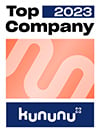Why user-centered design is important for software

If you design your software to be user-centered, you ensure that it has a high level of usability. But what exactly does that mean? And why is a high level of usability important? In this article, we would like to tell you more about user-centered software design so that you can implement these approaches in your next development project.
Reading time 5 min
- What is user-centered design?
- Why is user-centered design important?
- How you can implement the methods of user-centered design in your company
- Our conclusion
- FAQ on user-centered design for software
What is user-centered design?
User-centered design is used in software development to focus on the needs, expectations and abilities of users when using the software. The finished digital application should be particularly user-friendly and effective. Usability plays a central role here, as it ensures that the software is not only functional, but also easy and intuitive to use, which significantly increases user acceptance and satisfaction.
Individual steps in user-centered design are applied iteratively so that user needs and feedback on the software can be incorporated throughout the entire development process. This means that they are repeated several times in the same or at least a similar form until a satisfactory product is created that is precisely tailored to the user.
The basic principles of user-centered design
The iterative process of user-centered design usually consists of four phases. In the first phase, the focus is on user research, where the context in which the application is used by the users is examined. The main goal of this phase is to develop a deep understanding of the users. Why do they use the software? What are their needs, goals and behaviors?
In this phase, all relevant information about the future users is collected. This is done, for example, through interviews, surveys, observations, analyses and other methods. User profiles can also be created on the basis of these findings.
The next step, the definition of requirements, involves converting these findings into requirements for the software. These should be taken into account in the first draft or prototype. We then move on to the third step, namely conception and design, where these requirements are implemented using prototypes, mockups and design documents.
In the final step of the iterative process, the evaluation, concept papers, drafts etc. are tested and discussed with users to check whether the user requirements have already been implemented.
Why is user-centered design important?
User-centered design has advantages in many respects. It is not only important for the users of your software, but also from your perspective as a company. We would like to briefly summarize the advantages for you. If you are not yet convinced, these plus points will definitely change your mind:
- Intuitive use: thanks to the focus on the needs and wishes of end users, they can use the end product efficiently and without any queries
- Higher user satisfaction: If a product is easy and pleasant to use, then the user will most likely be more satisfied with its use. This in turn will make them more likely to reuse the product
- Better user loyalty: If the user realizes that the product is easy to use, they will use it again and are more likely to stay with you as a user. They may even recommend it to others.
- Consider diversity: If you know who your users are and tailor the end product to them, you can also cater to people with disabilities, for example, and make the products usable
- Less risk: By focusing on the user, you can reduce the risk of your product not being accepted on the market
- Less development time and costs: By involving users right from the start, you prevent development from going in the wrong direction. You can identify problems early on and save time and money
- More trust: Because you involve users right from the start and the product is well thought out, you ensure that users have more trust in you and your company. This is because you take their needs into account and ensure that your products can be used by real people in real life
How you can implement the methods of user-centered design in your company
Now you've learned a lot about the theory and perhaps even gained a little insight into how user-centered design can be applied to software in practice. Nevertheless, we would like to give you a few tips on how you can implement the methodology in your company so that you can create software that really focuses on the user.
User research in practice
The first step is, of course, about the user. So that you can gather all the information about your future users, you should first think about which users would use your product. You can then check this initial assessment in interviews or surveys and use them to better understand your target group. Analyze the results of your research and assign them to user profiles. You should also develop user scenarios to go with this. In other words, when do your users use the software and in what context? This will give you a foundation for the development of your application.
Define requirements: Develop ideas
Now it's time to implement the findings of the user research. Develop ideas with your team on how you can take your users' needs into account in the software. To do this, you should think about specific functions and also develop a plan for how users will use your software in the future. With a concept, you can record the requirements that your users have and that you want to take into account in the end product.
Prototyping and design
With the help of the requirements, you can now create a design for the user interface. Depending on your chosen approach, it is then time to develop an interactive prototype. This should illustrate the core functions of the software. In this step, you can also show your prototypes to users and record their feedback so that you can analyze it in the next step. For example, you can invite users to your premises and show them the prototype. Make a note of how they react to it and any problems they encounter. Or you can let them test your prototype themselves at home. Software that records user reactions and activities when using your prototype is suitable for this. Of course, interviews or surveys are also possible.
Iterative evaluation process
Now that you have received the initial feedback, you also need to analyze it in order to draw conclusions for further development. Where is there still room for improvement? Once you have found this out, it's time for implementation. Once you have adapted your prototype based on the feedback, it's time to let users test your product again. Again, you record the reactions and feedback so that you can make further adjustments. You repeat this to continuously improve your software. If there are no more suggestions for improvement at a later stage, your software is ready for the wider market. However, it is still worthwhile gathering user feedback from time to time and adapting your software application. Some challenges in use may only become apparent after some time. Technical innovations and changes also mean that your software no longer fits the standard or simply needs to be updated.
Our conclusion
Overall, user-centered design is a very good method for adapting software precisely to its users. As the user is always involved, the risk of an application that nobody wants to use is reduced. The software can also be adapted again and again and does not lose its relevance so quickly if it is already on the market.
We are happy to help you create software that is precisely tailored to the wishes and needs of users. Thanks to our many years of expertise in software development, we can meet every need and work with you to develop unique software that suits your company. Get in touch with us for an initial, no-obligation consultation!
FAQ on user-centered design for software
Last but not least, we would like to answer a few questions that may arise around the topic of user-centered design and usability. If you have any other questions, we will also be happy to help you. Simply contact us by phone or fill out our contact form. We will get back to you as soon as possible.
-
And what is UX?
UX stands for user experience. In principle, UX is very similar to user-centered design, as it is also about the user's experience with the software application. Interaction in terms of practicality, emotionality, efficiency and ergonomics plays an important role.
If you would like to find out more about UX design, you can read the interview with our graphic designer Leonie. Among other things, she reveals how the target group can be taken into account in UX design and which tools she uses
-
How can you measure usability?
The usability of software plays a central role in user-centered design. This can be checked with various tests. For example, one option would be to give users a specific task and check how long it takes them to complete it and how many mistakes are made. Another option is a heat map visualization. This allows you to see where users look most often and where they click. There are also other tools that can help you check usability.
Was ist dein Projekt? Wenn du uns darüber erzählen möchtest, rufen wir dich zurück!

Hello, my name is Meike. I take care of the EXWE back office and am responsible for our social media channels. All of our articles are meant to make your life easier and help you make decisions. Nevertheless, it can happen that something remains unclear, so: If you have questions about this article you can easily reach me at +49 231 93149827.
Discover the difference between software development and application development with our comprehensive guide for beginners. Find out what skills and career paths could be waiting for you. The right path for your future awaits!
Take advantage and outsource IT tasks now - save time and financial resources and utilize the know-how of experienced software developers!
Which database is right for you? Find out! In our article, we compare well-known database applications such as MySQL and MariaDB.





